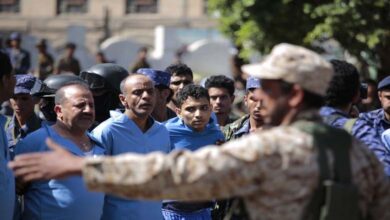Houthis Activate Emergency Plan as Fear Undermines Centralized Military Command

Following Israeli strikes targeting the leadership hierarchy within their ranks, Yemen’s Houthi movement has activated an internal emergency plan. Having observed how recent Israeli operations dismantled parts of Hezbollah’s command structure, the Houthis appear determined to prevent a similar collapse by implementing precautionary measures to limit potential damage in the event of comparable attacks.
According to security and military sources in Sanaa, the Houthis have decided to “grant broad authority to regional military zones and merge their five intelligence and security agencies under a single unified command structure to prevent external infiltration into the new hierarchy.” These measures are designed to decentralize power and distribute decision-making authority gradually, the sources added.
-
Houthis detain UN staff, including UNICEF representative
-
The Deluge toll: 1,000 Houthis killed in 19 months
Regional Armies
The same sources revealed that the Houthis have “authorized their regional military commanders to act independently and make operational decisions without referring to central command or awaiting directives from the Ministry of Defense,” effectively transforming each zone into a self-contained army.
The six Houthi military regions are: the “Central Military Zone” led by Abdelkhaleq al-Houthi, the “Fourth Zone” led by Abdelatif al-Mahdi, the “Fifth Zone” under Aqil al-Shami, the “Sixth Zone” led by Jamil Zaraa, the “Third Zone” under Mubarak al-Mashan, and the “Seventh Zone” commanded by Nasser al-Mohammadi.
This delegation of authority to field commanders reflects an attempt to relieve pressure on the central command in Sanaa, following the killing of Chief of Staff Mohammed Abdelkarim al-Ghamari in an Israeli airstrike on August 28. His death created a significant vacuum within the Houthi military leadership.
-
Between Denial and Confusion: Why Did the Houthis Delay Announcing Their Casualties?
-
Houthis redeploy military communication networks in Hodeidah
Security Restructuring
The sources further stated that the group has “established a National Defense Council in each governorate,” chaired by the local supervisor appointed by the Houthi leader’s office, making him the top local decision-maker overseeing intelligence, security, and local administration.
At the same time, the Houthis have begun restructuring their intelligence apparatus by merging multiple agencies into a single organization and strengthening provincial branches to operate autonomously as regional command centers. Each provincial Defense Council head will be responsible for approving the implementation of directives issued from subordinate units.
-
Food for loyalty… how the Houthis turned their territories into a vast prison
-
Houthis Claim Responsibility for Attack on Cargo Ship in the Gulf of Aden
The five intelligence and security bodies expected to merge are: Preventive Security, headed by Ahsan al-Humran; Police Intelligence, led by Ali Hussein al-Houthi; the Security and Intelligence Service, directed by Abdelhakim al-Khiwani; Revolutionary Security, led by Jafar al-Marhabi; and Military Intelligence, under Abu Ali al-Hakem.
Additionally, the Houthis have formed “Jihad Councils” in each province, comprising five leaders, including a representative of the provincial intelligence branch. They also established a special security unit tasked with protecting senior officials, detached from traditional security structures but operating under the supervision of the central intelligence command through a single communication channel.
-
Call for an international coalition against the Houthis: Experts stress collective action as essential for deterrence
-
Houthis Preempt September 26 Anniversary with Arbitrary Abductions in Sanaa and Ibb
The Houthis maintain full control over the provinces of Amran, Sanaa, Al-Mahwit, Dhamar, Raymah, Ibb, and Al-Bayda, while they partially control seven others — Al-Jawf, Marib, Taiz, Al-Dhalea, Al-Hodeidah, Saada, and Hajjah — which remain volatile front-line areas.












